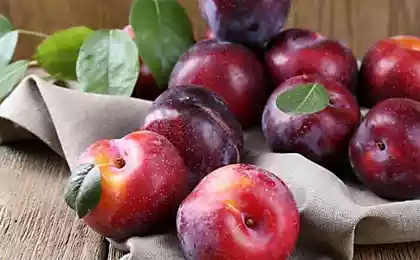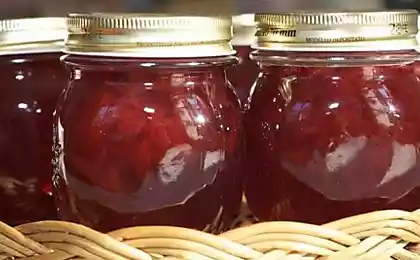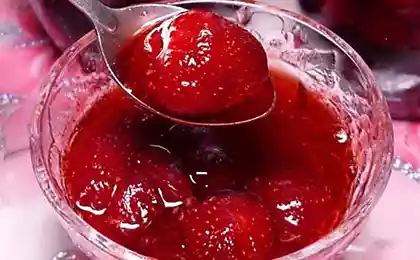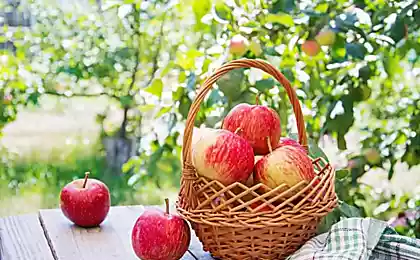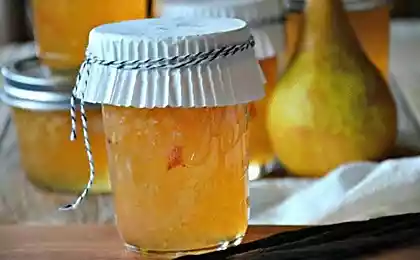254
Chinese (and Paradise) Apple Jam
Two recipes of jam from Chinese and paradise apples.
Chinese and Paradise apples are cooked according to the same recipes. Chinese apples differ from paradise in that they are smaller. In general, varieties, and those and others, a lot (the authors personally over the years counted about two dozen). The pictures show jam made of Chinese apples, and the paradise in one of the photos is just for comparison with the Chinese.
To cook jam (any), you need only in the basins and better in copper, especially existing for this purpose. If there is no copper pelvis, then take enameled.
The first option and it, according to the authors, is better than the second option, taken from the book by P.P. Alexandrova-Ignatieva “Practical Foundations of Culinary Art” in 1909.
It is better because the apples retained their shape and they can really be taken by the tails, which can be seen in the photo where the apples in the pelvis (the authors specifically laid out from the pelvis 1⁄2 of the finished apples, so that you could assess the transparency of the syrup after boiling).
The recipe of Alexandrova-Ignatieva:
“Chinese apple jam.
Selecting good, not particularly ripe Chinese apples, cut some stems, cut off the beards and pin them, or, best of all, pierce a wooden peg along the way. This is done so that the apples are filled with syrup. After that, cool them like peaches, and cook in a light syrup for 4-5 days, giving each day to boil once. When they are ready, they will become completely transparent, and the syrup should become thick - stretch between the fingers in the form of a thin thread. Sugar is taken as usual.”
? “As usual” in Alexandrova-Ignatieva, it is when for every pound of apples a pound of sugar and a pound of water are taken.
Explanation to the prescription:
in this recipe (pictured jam in the pelvis) taken for 1 kg of apples -1 kg of sugar-1 liters of water. The apples were blanched in boiling water for 3 minutes and did not cool. The jam was boiled in 4 receptions. Punctures are made using wooden toothpicks. A copper pelvis was used. It is in copper basins that it is best to cook jam (if not, enameled and cook it in the basins, and not in pots and other items not intended for cooking jam) and most importantly, you need to choose a pelvis so that the fruits are calmly placed in the pelvis, were immersed in syrup, and not huddled and do not fill the entire volume of the pelvis! During boiling, the pelvis with jam is better to shake a little and kind of move, so as not to damage the shape of the fruits and not to turn the jam into a sticky mass. (For this purpose, copper pelvis with handles were produced before, but now they are not!) If, however, there is a need to prevent the apple, it is better to take a narrow wooden spoon (and carefully touch the apples without fanaticism).
Ready jam to decompose in clean, pre-scalded boiling water cans (dry), close with plastic covers. Store as usual (better in a cool place of course).
The second option is common - not bad, but apples keep the shape worse than in the recipe from Alexandrova-Ignatieva, which can be seen in the picture where the jam is already packed in a jar.
The second option recipe
Apples (Chinese or paradise) - 1 kg, wash, trim the peduncles so that 2-3 cm would remain, with the help of a toothpick make 4-5 punctures in apples (distribute punctures along the "equator", blanch in boiling water for 3 minutes, cool, dip in hot syrup, and cook until boiling. Then cook jam in 3 receptions for 5 minutes (between receptions there should be a time of 12 hours). During the last boiling, you can add vanilla or a cinnamon stick, which is removed as soon as the jam is ready. Decompose in clean, dried cans (banks pre-load with boiling water as well as plastic covers and dry).
Keep it as normal (better in a cool place).
Done.
In the photos of apple trees from which were collected Chinese apples and paradise apples in a basket. The photo, where the jam in the pelvis, brewed according to the recipe of Alexandrova-Ignatieva, in the photo, where the jam is in the jar, the jam is cooked according to the second option.
It is better to cook syrup 1.5 times more, it is better because apples retain their shape better and they are not “spacious” – better in one word.
Source: bufetum.livejournal.com/44715.html
Chinese and Paradise apples are cooked according to the same recipes. Chinese apples differ from paradise in that they are smaller. In general, varieties, and those and others, a lot (the authors personally over the years counted about two dozen). The pictures show jam made of Chinese apples, and the paradise in one of the photos is just for comparison with the Chinese.
To cook jam (any), you need only in the basins and better in copper, especially existing for this purpose. If there is no copper pelvis, then take enameled.
The first option and it, according to the authors, is better than the second option, taken from the book by P.P. Alexandrova-Ignatieva “Practical Foundations of Culinary Art” in 1909.
It is better because the apples retained their shape and they can really be taken by the tails, which can be seen in the photo where the apples in the pelvis (the authors specifically laid out from the pelvis 1⁄2 of the finished apples, so that you could assess the transparency of the syrup after boiling).
The recipe of Alexandrova-Ignatieva:
“Chinese apple jam.
Selecting good, not particularly ripe Chinese apples, cut some stems, cut off the beards and pin them, or, best of all, pierce a wooden peg along the way. This is done so that the apples are filled with syrup. After that, cool them like peaches, and cook in a light syrup for 4-5 days, giving each day to boil once. When they are ready, they will become completely transparent, and the syrup should become thick - stretch between the fingers in the form of a thin thread. Sugar is taken as usual.”
? “As usual” in Alexandrova-Ignatieva, it is when for every pound of apples a pound of sugar and a pound of water are taken.
Explanation to the prescription:
in this recipe (pictured jam in the pelvis) taken for 1 kg of apples -1 kg of sugar-1 liters of water. The apples were blanched in boiling water for 3 minutes and did not cool. The jam was boiled in 4 receptions. Punctures are made using wooden toothpicks. A copper pelvis was used. It is in copper basins that it is best to cook jam (if not, enameled and cook it in the basins, and not in pots and other items not intended for cooking jam) and most importantly, you need to choose a pelvis so that the fruits are calmly placed in the pelvis, were immersed in syrup, and not huddled and do not fill the entire volume of the pelvis! During boiling, the pelvis with jam is better to shake a little and kind of move, so as not to damage the shape of the fruits and not to turn the jam into a sticky mass. (For this purpose, copper pelvis with handles were produced before, but now they are not!) If, however, there is a need to prevent the apple, it is better to take a narrow wooden spoon (and carefully touch the apples without fanaticism).
Ready jam to decompose in clean, pre-scalded boiling water cans (dry), close with plastic covers. Store as usual (better in a cool place of course).
The second option is common - not bad, but apples keep the shape worse than in the recipe from Alexandrova-Ignatieva, which can be seen in the picture where the jam is already packed in a jar.
The second option recipe
Apples (Chinese or paradise) - 1 kg, wash, trim the peduncles so that 2-3 cm would remain, with the help of a toothpick make 4-5 punctures in apples (distribute punctures along the "equator", blanch in boiling water for 3 minutes, cool, dip in hot syrup, and cook until boiling. Then cook jam in 3 receptions for 5 minutes (between receptions there should be a time of 12 hours). During the last boiling, you can add vanilla or a cinnamon stick, which is removed as soon as the jam is ready. Decompose in clean, dried cans (banks pre-load with boiling water as well as plastic covers and dry).
Keep it as normal (better in a cool place).
Done.
In the photos of apple trees from which were collected Chinese apples and paradise apples in a basket. The photo, where the jam in the pelvis, brewed according to the recipe of Alexandrova-Ignatieva, in the photo, where the jam is in the jar, the jam is cooked according to the second option.
It is better to cook syrup 1.5 times more, it is better because apples retain their shape better and they are not “spacious” – better in one word.
Source: bufetum.livejournal.com/44715.html





